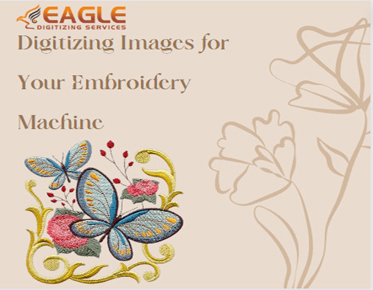How Can You Craft Stitching Masterpieces by Digitizing Images for Your Embroidery Machine?
Embroidery has undergone a remarkable transformation in recent years, thanks to the advancements in digitization technology. What was once a painstaking manual process has now become more streamlined and precise, allowing embroiderers to create intricate designs with ease. In this article, we'll delve into the fascinating world of digitizing images for embroidery machines, exploring the steps involved and highlighting the importance of achieving high-quality digitization for professional results.
Understanding
Digitization
Embroidery digitization in USA lies at the heart of modern embroidery, serving as the bridge between digital images and stitched designs. Essentially, it involves converting digital images into stitch files that embroidery machines can interpret and execute. This process is critical for ensuring the accuracy and clarity of the final embroidered design, as it dictates how the machine will translate the digital image into stitches. Digitizing software plays a pivotal role in this process, providing embroiderers with the necessary tools and features to manipulate and refine the design to perfection.
Preparing
Images for Digitization
Before diving into embroidery digitization, it's essential to prepare the images properly to ensure optimal results. This involves carefully selecting images that are well-suited for embroidery, with clear outlines, distinct colors, and minimal intricate details. Images with high contrast and defined edges tend to digitize more effectively. Additionally, optimizing images for clarity and stitchability requires adjustments to factors such as color depth, brightness, and contrast. By fine-tuning these elements, embroiderers can enhance the overall quality of the digitized design and streamline the digitization process.
Choosing
the Right Digitizing Software
With a plethora of digitizing software options available in the market, choosing the right one can be a daunting task. Popular choices include industry-leading software such as Wilcom, Pulse, and Hatch, each offering its own unique features and capabilities. When selecting digitizing software, it's essential to consider factors such as user-friendliness, available tools, and compatibility with your embroidery machine. Additionally, exploring demo versions or trial periods can help you assess the software's suitability for your needs before making a final decision.
The Digitizing Process Step-by-Step
- Importing the Image: Embark
on your digitization voyage by importing the chosen image into your
software of choice.
- Tracing Outlines: Like a
master sculptor, trace the contours of your image, defining its essence
and form.
- Assigning Stitch Types: Bestow
life upon your creation by assigning stitch types and directions,
orchestrating a symphony of textures.
- Fine-Tuning Details: Refine your masterpiece with precision, adjusting parameters like stitch density and underlay to perfection.
Understanding
Stitch Types
Different stitch types serve distinct purposes in embroidery digitization, each contributing to the overall texture and appearance of the design. Satin stitches, for example, are ideal for creating smooth, continuous lines, making them well-suited for outlining and lettering. Fill stitches, on the other hand, are used to cover larger areas with color, providing depth and dimension to the design. By understanding the characteristics and applications of different stitch types, embroiderers can strategically employ them to achieve their desired aesthetic.
Customizing
Stitch Settings
Customizing stitch settings allows embroiderers to tailor the appearance and texture of their designs to suit their preferences. Adjusting parameters such as stitch density, length, and angle can significantly impact the overall look and feel of the embroidery. Additionally, modifying underlay – the foundation stitches that provide stability and support to the design – can enhance the visual appeal and durability of the finished product. By experimenting with different stitch settings and effects, embroiderers can unleash their creativity and achieve stunning results.
Testing
and Refining
Stitching out test samples is a crucial step in the embroidery digitizing process, allowing embroiderers to evaluate the design quality and make necessary adjustments. By testing different stitch settings and effects on various fabrics and materials, embroiderers can assess how the design will translate into real-world applications. This iterative process of testing and refining ensures that the final design meets the desired standards of quality and consistency.
Handling
Complex Designs
Digitizing complex designs requires careful planning and attention to detail to ensure optimal results. Strategies for digitizing intricate details and managing color changes and gradients include breaking down large designs into manageable sections and prioritizing stitching order based on design complexity. Additionally, employing techniques such as layering and blending can help achieve seamless transitions and realistic effects. By approaching complex designs strategically, embroiderers can overcome challenges and produce stunning embroidered masterpieces.
Ensuring
Compatibility with Embroidery Machines
Ensuring compatibility with embroidery machines is essential to ensure smooth stitching and optimal results. This involves saving digitized files in compatible formats, such as .DST or .PES, which are recognized by embroidery machines. Additionally, considering machine limitations and capabilities – such as hoop size and stitch count – helps prevent issues and ensures seamless integration with the embroidery process. By testing compatibility with embroidery machines before finalizing designs, embroiderers can identify any potential issues or discrepancies and make necessary adjustments to ensure a flawless stitching experience.
Quality
Assurance and Final Checks
Before sending designs to the embroidery machine, conducting thorough quality checks is essential to ensure the integrity and accuracy of the final product. This involves verifying stitch counts, densities, and alignments to ensure consistency and precision in the embroidery. Additionally, inspecting the design for any stray stitches, gaps, or distortions helps identify and rectify any potential issues before stitching. Making any final adjustments or refinements based on quality assurance checks ensures that the design is stitch-ready and meets the highest standards of excellence.
Conclusion
In conclusion, digitizing images for embroidery machines is both an art and a science, requiring skill, precision, and attention to detail. By following the steps outlined in this guide and embracing experimentation and practice, embroiderers can unlock a world of creative possibilities and produce stunning stitched masterpieces. Whether you're a seasoned embroiderer or just starting out, the digitization process offers endless opportunities for creativity and innovation. With dedication, patience, and a commitment to excellence, you can elevate your embroidery projects to new heights and create stitching masterpieces that truly stand out.
Eagle
Digitizing for Embroidery Digitization
For embroiderers seeking professional
assistance with digitizing their designs, Eagle Digitizing offers expert
services with quick turnaround times, skilled digitizers, and strict quality assurance measures. With Eagle Digitizing's
expertise and dedication to excellence, you can trust that your embroidery digitizing needs will be met
with precision and professionalism. Whether you're digitizing simple logos or
complex designs, Eagle Digitizing ensures that your designs are brought to life
with exceptional detail and accuracy. Experience the difference with Eagle
Digitizing and unlock the full potential of your embroidery projects today.



